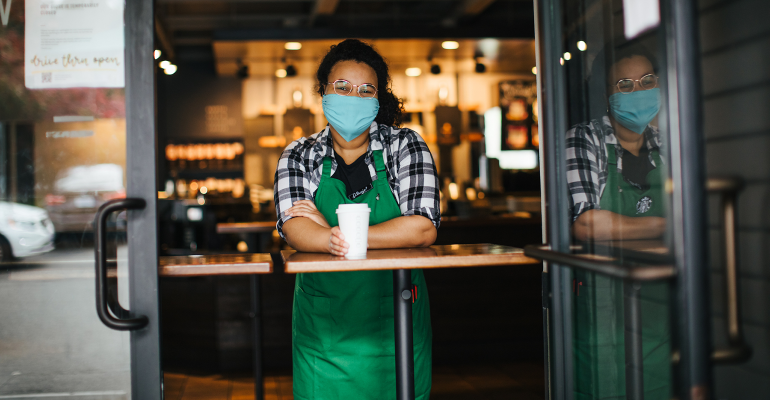Over the past two weeks as Starbucks began reopening stores across the U.S., the company has regained about 60%-65% of its prior year sales levels, according to a business update from CEO Kevin Johnson. He also noted that China has reached about 80% of its prior year sales. While Johnson expressed optimism at the “gradual improvement” of their systemwide performance he noted that with changes to consumer trends and habits, they will have to adapt.
Here are some of the operational changes Starbucks has made or will begin to implement as stores reopen in the “monitor and adapt” phase of recovery and beyond:
Starbucks will begin leaning into an “on the go” format
Although Starbucks has been investing in its café experiences, from the growth of Starbucks Reserve Stores to its “third place” mantra, Johnson said in his business update that they’ll be transforming their third place priority to appeal to customers that will likely prefer a grab-and-go format over a sit-and-chat experience.
“Since approximately 80% of our store transactions before the crisis were on the go, driven in many ways by the use of the Starbucks mobile app, we were already adapting to new consumer trends that balance the need for convenience on-the-go with the desire for connection in our stores,” Johnson said in his business update.
Johnson said that the “broader store transformation” to reflect the on-the-go needs of their customers that they already had planned before COVID-19 will be accelerated from a three- to five-year period to a 12-18-month period.
We will see more pickup-only stores
As part of this store transformation Starbucks will begin opening more pickup-only stores. Starbucks’ first pickup-only store in the U.S. opened in November in New York City’s Penn Plaza, similar to the first Starbucks Now express store format that first opened in Beijing in the summer of 2019.
“Over the last two years, we studied how customers experience our stores in dense markets and have realized that increased mobile pickup orders were crowding our stores and reducing the quality of the experience for many customers,” Johnson said in his business update.
Curbside pickup options will extend beyond the crisis recovery phase
Although many restaurants are utilizing curbside pickup as a solution driven by pandemic-related consumer fears, Starbucks sees a place for this type of convenience even after we reach a new normal.
“Our customers will soon see more curbside pickup options as well as delivery – all formats optimized for the current crisis and a future of changing consumer expectations for the third place across the U.S.,” Johnson said.

Starbucks store hours and labor needs are reduced
Starbucks closed its business update with a look at how labor is being affected by the COVID-19 road to recovery. Although Johnson maintained optimism that operations and sales have been steadily improving, he explained that labor demands are not as high as they were in a pre-pandemic world. As traffic still continues to build back up to where it used to be, store hours may be reduced and store employee hours will become scarcer.
“It is important that we are open and honest about the current reality of the COVID-19 economy, and work directly with each partner to ensure they understand the options in front of them whether they choose to stay with Starbucks or choose to pursue a different path,” Johnson said.
For employees that do choose to stay, Starbucks is extending its unpaid COVID-19 leave policy through the end of September, which will give employees access to emergency healthcare benefits the company has rolled out over the past couple of months, as well as their usual healthcare benefits.
For our most up-to-date coverage, visit the coronavirus homepage.
Contact Joanna Fantozzi at [email protected]
Follow her on Twitter: @JoannaFantozzi


